Back to the Home page
Bull Ings, Cropton – June 27th 2012
species lists below
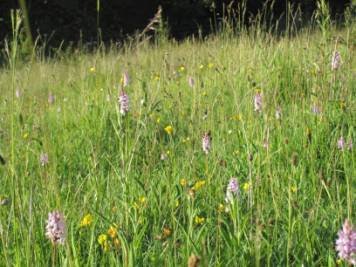 A beautiful evening, despite the potential for rain, welcomed 10 participants to this meeting at 6.30pm. It took on a slightly different form in that we were visiting a Site of Special Scientific Interest (SSSI) specifically for the flora and not taking a circular walk. The orchids did not disappoint although there was a lack of butterflies. Due to the nature of this walk individuals were able to leave as they desired, with most having concluded by 8.30pm. The three botanists reluctantly finished at 10pm.
A beautiful evening, despite the potential for rain, welcomed 10 participants to this meeting at 6.30pm. It took on a slightly different form in that we were visiting a Site of Special Scientific Interest (SSSI) specifically for the flora and not taking a circular walk. The orchids did not disappoint although there was a lack of butterflies. Due to the nature of this walk individuals were able to leave as they desired, with most having concluded by 8.30pm. The three botanists reluctantly finished at 10pm.
Bull Ings SSSI consists of two pastures which offer a full range of flora, including four types of orchid. It is damp in places, very dry in others and is acidic in part and calcareous elsewhere. It has something to offer throughout the flowering season with a good show of primrose and cowslip early on, orchids now and devils bit scabious, betony, common knapweed, greater burnet and pepper-saxifrage, to name but a few, later on. Sedges and grasses also do well here. In good weather it is a haven for butterflies.
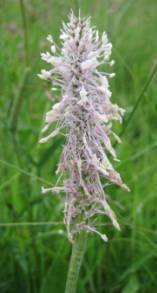
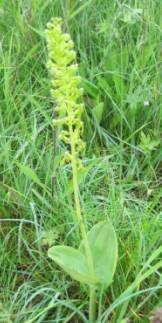
We did not record flora en route to the site but it is worth mentioning the hoary plantain (right) which grows on the west verge at the top of Cropton Bank, opposite the small green. There are plenty of spikes here in a small area of limestone. Its flowers are a rather delicate pink-mauve and much more showy than ribwort or greater plantain. Although not rare it is uncommon in this area.
At the SSSI the abundance of common spotted orchid is quite a spectacle. What is less obvious is the presence of common twayblade (left), though both orchids must number in their hundreds. Early purple orchid is far less in number, no more than ten, and all were over flowering on this visit.
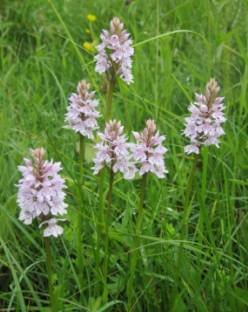
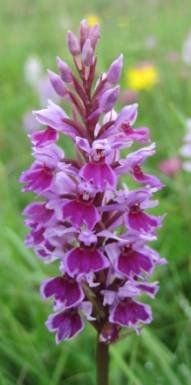
The common spotted orchid can vary considerably in colour and size. Most often they are a pale pink (as shown left below) but we did find some almost white specimens and others that were very dark. The one shown right below is very dark with pale edging as all the central spots and lines have coalesced. This plant also had leaves so heavily spotted they appeared dark purple with small green patches.
What is particularly special at this site is the bee orchids (see below), which were just coming into flower with plenty of buds yet to open. We counted 20 spikes, 18 in one location and two more at two other sites in the fields. There are potentially more but they are very hard to see when still in bud. A further visit will give a more accurate number. This does seem to be a good year for bee orchids, despite the cool, wet summer so far.
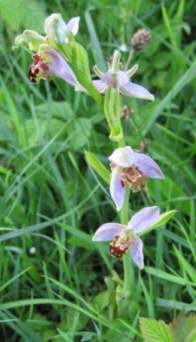
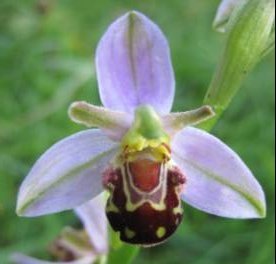
Common knapweed, betony, greater burnet and devils bit scabious were all in bud and very abundant. Again these will be a pleasure to see when in flower. We did find the leaves of pepper-saxifrage but none of the yellow umbels were evident as this is also a late flowerer. It is rare in this area but gives quite a good show at this site.
On this visit we were able to add quite a few additions to the already comprehensive list of species here. One good find was flea sedge adding to pale, tawny, carnation, wood, spring and glaucous sedges already recorded. Another good find was about eight spikes of yellow rattle, previously unrecorded here. Only five minutes before finding it, one botanist happened to remark that yellow rattle ought to be present given the other flora seen.
Grasses include predominantly quaking grass, downy and false oatgrass, tufted hairgrass and crested dogstail. Meadow and red fescue is also found here.
Species lists
Birds:
The following birds were recorded during the evening. Many thanks to Ken for the list. Wren, blackbird, chaffinch, starling, house sparrow, swallow, house martin, swift, goldcrest, song thrush, greenfinch, wood pigeon, chiffchaff, yellowhammer, skylark, crow, rook, jay, jackdaw, garden warbler, blue tit and pied wagtail.
Plants:
Flora recorded at this site, totalling 108.
| English name | Latin name |
| Agrimony | Agrimonia eupatoria |
| Anemone,wood | Anemone nemorosa |
| Angelica,wild | Angelica sylvestris |
| Avens,water | Geum rivale |
| Avens,wood | Geum urbanum |
| Bedstraw,ladys | Galium verum |
| Betony | Stachys officinalis |
| Birdsfoot trefoil,common | Lotus corniculatus |
| Blackthorn | Prunus spinosa |
| Bluebell | Hyacinthoides non-scripta |
| Bramble | Rubus fruticosus agg. |
| Brooklime | Veronica beccabunga |
| Bugle | Ajuga reptans |
| Burdock,lesser | Arctium sp |
| Burnet,great | Sanguisorba officinalis |
| Burnet,salad | Sanguisorba minor |
| Buttercup,meadow | Ranunculus acris |
| Campion,red | Silene dioica |
| Catsear | Hypochaeris radicata |
| Cinquefoil,creeping | Potentilla reptans |
| Cleavers | Galium aparine |
| Clover,red | Trifolium pratense |
| Clover,white | Trifolium repens |
| Clover,zig-zag | Trifolium medium |
| Cow parsley | Anthriscus sylvestris |
| Cowslip | Primula veris |
| Cranesbill,meadow | Geranium pratense |
| Crosswort | Cruciata laevipes |
| Cuckooflower | Cardamine pratensis |
| Daisy,common | Bellis perennis |
| Daisy,oxeye | Leucanthemum vulgare |
| Dandelion | Taraxacum agg. |
| Dock,wood | Rumex sanguineus |
| Fairy flax | Linum catharticum |
| Forget-me-not,field | Myosotis arvensis |
| grass,false oatgrass | Arrhenatherum elatius |
| grass,cocksfoot | Dactylis glomerata |
| grass,crested dogstail | Cynosurus cristatus |
| grass,downy oatgrass | Helictotrichon pubescens |
| grass,meadow fescue | Festuca pratensis |
| grass,meadow foxtail | Alopecurus pratensis |
| grass,perennial ryegrass | Lolium perenne |
| grass,quaking | Briza media |
| grass,red fescue | Festuca rubra |
| grass,rough meadowgrass | Poa trivialis |
| grass,sweet vernal | Anthoxanthum odoratum |
| grass,tufted hairgrass | Deschampsia caespitosa |
| grass,wavy hairgrass | Deschampsia flexuosa |
| grass,Yorkshire-fog | Holcus lanatus |
| Guelder-rose | Viburnum opulus |
| Harebell | Campanula rotundifolia |
| Hawkbit,rough | Leontodon hispidus |
| Hawkweed,mouse-ear | Pilosella officinarum |
| Hawthorn | Crataegus monogyna |
| Herb robert | Geranium robertianum |
| Hogweed | Heracleum sphondylium |
| Honeysuckle | Lonicera periclymenum |
| Horsetail,field | Equisetum arvense |
| Knapweed,common | Centaurea nigra |
| Lady's mantle | Alchemilla sp |
| Lords-and-ladies | Arum maculatum |
| Meadowsweet | Filipendula ulmaria |
| Medick,black | Medicago lupulina |
| Mercury,dogs | Mercurialis perennis |
| Milkwort,common | Polygala vulgaris |
| Orchid,bee | Ophrys apifera |
| Orchid,common spotted | Dactylorhiza fuchsii |
| Orchid,early purple | Orchis mascula |
| Pepper-saxifrage | Silaum silaus |
| Pignut | Conopodium majus |
| Plantain,ribwort | Plantago lanceolata |
| Primrose | Primula vulgaris |
| Ragwort,common | Senecio jacobaea |
| Red bartsia | Odontites vernus |
| Rose sp | Rosa agg. |
| Rush,compact | Juncus conglomeratus |
| Rush,hard | Juncus inflexus |
| Rush,jointed | Juncus articulatus |
| Rush,soft | Juncus effusus |
| Rush,toad | Juncus bufonius |
| Scabious,devilsbit | Succisa pratensis |
| Sedge,carnation | Carex panicea |
| Sedge,flea | Carex pulicaris |
| Sedge,glaucous | Carex flacca |
| Sedge,pale | Carex pallescens |
| Sedge,spring | Carex caryophyllea |
| Sedge,tawny | Carex hostiana |
| Sedge,wood | Carex sylvatica |
| Selfheal | Prunella vulgaris |
| Sorrel,common | Rumex acetosa |
| Speedwell,germander | Veronica chamaedrys |
| Speedwell,heath | Veronica officinalis |
| St. Johnswort,hairy | Hypericum hirsutum |
| St. Johnswort,slender | Hypericum pulchrum |
| Stitchwort,greater | Stellaria holostea |
| Stitchwort,lesser | Stellaria graminea |
| Thistle,creeping | Cirsium arvense |
| Thistle,marsh | Cirsium palustre |
| Tormentil | Potentilla erecta |
| Twayblade,common | Listera ovata |
| Valerian,marsh | Valeriana dioica |
| Vetch,bitter | Lathyrus linifolius |
| Vetch,tufted | Vicia cracca |
| Vetchling,meadow | Lathyrus pratensis |
| Violet,common dog | Viola riviniana |
| Woodruff | Galium odoratum |
| Yarrow | Achillea millefolium |
| Yellow rattle | Rhinanthus minor |
| © Ryedale Natural History Society 2012 |
Back to the Home page |
 A beautiful evening, despite the potential for rain, welcomed 10 participants to this meeting at 6.30pm. It took on a slightly different form in that we were visiting a Site of Special Scientific Interest (SSSI) specifically for the flora and not taking a circular walk. The orchids did not disappoint although there was a lack of butterflies. Due to the nature of this walk individuals were able to leave as they desired, with most having concluded by 8.30pm. The three botanists reluctantly finished at 10pm.
A beautiful evening, despite the potential for rain, welcomed 10 participants to this meeting at 6.30pm. It took on a slightly different form in that we were visiting a Site of Special Scientific Interest (SSSI) specifically for the flora and not taking a circular walk. The orchids did not disappoint although there was a lack of butterflies. Due to the nature of this walk individuals were able to leave as they desired, with most having concluded by 8.30pm. The three botanists reluctantly finished at 10pm.




